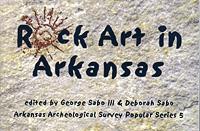Books on Arkansas Rock Art
Arkansas Archeological Survey Popular Series 5 The Archeology of Rock Art at The Narrows Rock Shelter, Crawford County, Arkansas, by Jerry E. Hilliard (with contributions by Gayle J. Fritz and Eben S. Cooper) is a technical report of 1995 excavations at one of Arkansas’s most important rock art sites. The Narrows is known for its remarkable panel of painted petroglyphs showing at least 15 anthropomorphic figures. The shelter floor deposits contained undisturbed midden rich in botanical and faunal remains, stone tools, and ceramics. Standard archeological analysis suggests occupation by family groups during fall and winter, with an emphasis on food processing activities and manufacture of siltstone hoes. The 1995 excavations produced the first ever in situ association of artifacts connected to rock art production in Arkansas. Radiocarbon dates and ceramics indicate Fort Coffee phase or Spiro phase associations. Fritz performed ethnobotanical analysis. Cooper experimented with photogrammetry to record the petroglyphs. Arkansas Archeological Survey Research Report 31 Please visit our Online Storefront for information on all books in print and how to order them. For questions or problems, please email archpubs@uark.edu or telephone 479-575-3556.
|
| Home | Quick Facts | Interpretations | Articles | Technical Papers | Resources | Database | Just For Kids | Picture Gallery | Buy the Book! |
|
Last Updated: October 5, 2023 at 9:41:27 AM Central Time
|

 Rock Art in Arkansas, edited by George Sabo III
and Deborah Sabo, with contributions by Michelle Berg Vogel and Jerry
E. Hilliard, provides an overview of current knowledge about Arkansas rock
art, incorporating the findings of ongoing research in a presentation
suitable for general readers as well as specialists. The 146-page book
has 70 illustrations (most in color), glossary, index, and bibliography.
Chapters cover the place of rock art research within archeology, the
history of rock art research in Arkansas, descriptive terminology, dating,
diversity of site types and imagery, interpretation of rock art sites as
part of a cultural landscape, and preservation concerns. Separate chapters
are devoted to two of Arkansas’s most important rock art sites,
The Narrows and Rockhouse Cave, with an updated assessment of the first
rock art style defined within Arkansas, the Petit Jean Painted style.
This book summarizes the foundation for new studies that relate Arkansas
rock art to the religious and mythological iconography of the Southeastern
Ceremonial Complex. Arkansas has one of the highest concentrations of
well-preserved prehistoric and early historic rock art, both pictographs
and petroglyphs, in the American Southeast. Rock Art in Arkansas
is the first comprehensive treatment of this important cultural resource.
Rock Art in Arkansas, edited by George Sabo III
and Deborah Sabo, with contributions by Michelle Berg Vogel and Jerry
E. Hilliard, provides an overview of current knowledge about Arkansas rock
art, incorporating the findings of ongoing research in a presentation
suitable for general readers as well as specialists. The 146-page book
has 70 illustrations (most in color), glossary, index, and bibliography.
Chapters cover the place of rock art research within archeology, the
history of rock art research in Arkansas, descriptive terminology, dating,
diversity of site types and imagery, interpretation of rock art sites as
part of a cultural landscape, and preservation concerns. Separate chapters
are devoted to two of Arkansas’s most important rock art sites,
The Narrows and Rockhouse Cave, with an updated assessment of the first
rock art style defined within Arkansas, the Petit Jean Painted style.
This book summarizes the foundation for new studies that relate Arkansas
rock art to the religious and mythological iconography of the Southeastern
Ceremonial Complex. Arkansas has one of the highest concentrations of
well-preserved prehistoric and early historic rock art, both pictographs
and petroglyphs, in the American Southeast. Rock Art in Arkansas
is the first comprehensive treatment of this important cultural resource.